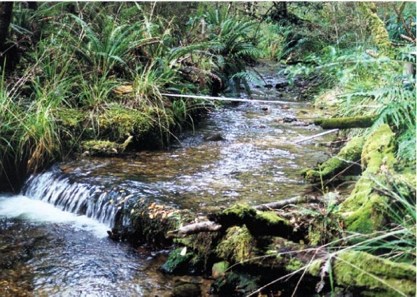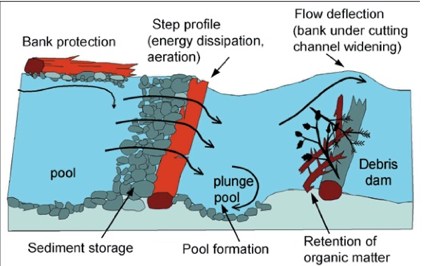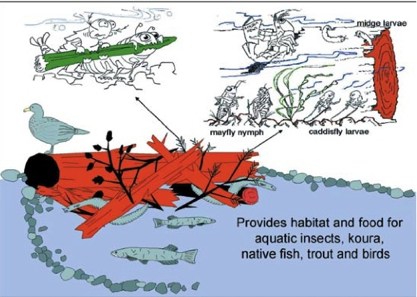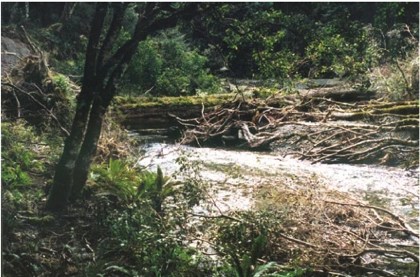Wood in streams - size really does matter
Brenda Baillie, New Zealand Tree Grower February 2005.
When the time comes for harvesting woodlots, most of us are aware of the risks associated with leaving large amounts of logging slash in streams. This is reflected in regional council and forest company rules, which usually advocate the removal of stem and branch material from streams after logging. What is often overlooked is the ecological benefit of wood in stream ecosystems.

Prior to the arrival of humans, much of the land was covered in forests. Wood was an integral part of stream ecosystems, and still is in remaining indigenous forests. So where is the balance between managing wood in streams for risk, especially after harvest, and the ecological benefit?
Ecological role of wood in stream ecosystems
What are the ecological benefits of leaving wood in streams? In forested stream ecosystems, wood plays a multitude of roles in stream processes and stream habitat. Wood-
- Slows down the stream flow, dissipating energy
- Helps aerate the water
- Diverts and deflects water flow
- Increases flow complexity
- Increases the number and variety of pools
- Protects bank edges
- Retains and slows down the movement of sediment, fine organic matter, and twigs and leaves through the stream system, increasing retention time for in stream processing by micro-organisms such as fungi and bacteria and aquatic insects
- Provides food resources and increases habitat diversity for native fish, trout, koura, aquatic insects and birds such the endangered blue duck
What sort of wood is most beneficial?

A look at our indigenous forest streams can provide a few clues. Factors contributing to the stability and longevity of wood include species, piece size, length, abundance, position in the channel, degree of burial and how well the piece is anchored. These key structural pieces have the greatest influence on the stream ecosystem and are often referred to as large woody debris.
Channel width also has a strong influence on the amount, distribution and influence of wood in the stream channel. The wood loadings influence on the stream system is higher in smaller streams. As the stream width and flow increase, wood is more easily dislodged and transported during floods, so volumes tend to decrease and the average size of the remaining pieces increases. Less wood remains in the main stream channel and more is stacked up along the bank edge.
It is important to remember that streams are not static systems. It is a natural process for wood to fall into streams, where it gradually breaks down, mainly through physical abrasion and decay as it is transported down through the stream system, with some pieces eventually ending up in lakes, estuaries, and along coastlines.
Wood in plantation forest streams

As plantation stands mature, windthrown trees often fall across and into the stream channel. While they may not be as large as some of the large woody debris found in native forest streams, these logs have all the characteristics of the key structural pieces in native forest streams. They are large, often straddling the stream channel, and usually have a partially intact root system which increases their resistance to movement. If left in place these pieces will gradually decay and enter the stream ecosystem.
Prior to harvest, most of the wood in pine plantation streams is composed of large woody debris, similar to what we find in native forest streams. Because most of the large merchantable pieces of wood are removed at harvest, a lot of smaller logs, branches and needles can end up in the stream channel. Most of the wood is less than 10 cm in diameter. This logging slash is very mobile during high flows and it is common practice to remove this material from the stream system to prevent it forming debris dams and causing damage downstream.

In the smaller, more stable streams, there is the potential to balance post-harvest woody debris stream-cleaning practices. This can be done by leaving behind large key structural pieces such as windthrown stems, and removing the majority of the finer logging slash, achieving a similar appearance and function to that found in native forest streams. There is no cost to the landowner to leave these pieces in place and there may even be cost savings if these pieces are currently removed as part of routine stream-cleaning practices.
However, this should be managed on a site-by-site basis, and in consultation with pertinent local authorities, taking into account factors such as hydrology, flood risk, geology, and stream size, and regional council rules. Some forest companies are already doing this.
Brenda Baillie works for the Centre for Sustainable Forest Management, Forest Research

 Farm Forestry New Zealand
Farm Forestry New Zealand